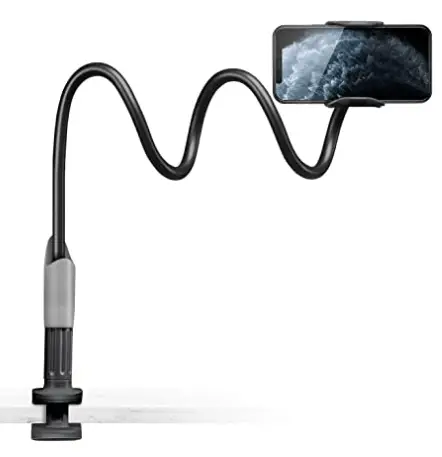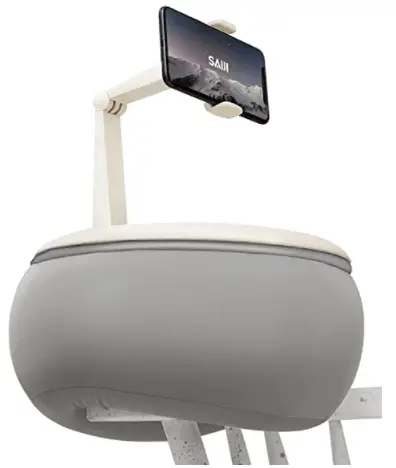Are you one of the many typical zombie-fied cellphone-addicted people, connected in the modern digital world of emails, social media, and the internet?
Nowadays, it’s difficult to pinpoint something that can’t be found, bought, or watched online, directly from our smartphone or tablet in the palm of our hands. With a whole list of possibilities at our fingertips, it’s not surprising that many of us develop a dependency on our little pocket rockets. Each day, people spend hours looking down at their hand-held device, whether it be for work, education, social or just to fill the time.
Best Gadgets for Smartphones & Tablets
What many people fail to realize is that frequent overuse of such technology, in conjunction with poor ergonomics, can be responsible for a number of health issues. The consequences are usually musculoskeletal based (joints, muscles, nerves, ligaments, etc), but have also less commonly been linked to cases of ill health and sickness. Make yourself aware of the risks associated.

Hold or position the device at eye level
As your head tilts forward to look down at your phone or tablet, you are putting a great deal of force on your cervical spine (neck). This delicate structure houses your spinal cord, which sends messages from the brain to all areas of your body. When you hold the device directly in front of you, your head will retain its healthy and neutral position and therefore minimizes the strain on your neck. If you can’t do anything about the positioning, move your eyes to look down and not your neck.
Alternate between thumb and fingers to type
Constantly using your thumbs to type, particularly on smartphones, can lead to undesirable repetitive strain injury otherwise known as De Quervain syndrome. The repeated action of pressing buttons, virtual or on a keypad, will cause a gradual onset of pain in the thumbs and wrists. To avoid this, alternate between using your thumbs and fingers to type – it may feel unnatural at first, but it doesn’t take too long to master. Tip: Turn your device on its side to reveal a larger keyboard, making it easier to type with your fingers.
Keep wrists as relaxed as possible
Ensure your wrists are straight and relaxed using a comfortable neutral grip on the device. If they are bent or twisted, not only will it cause strain in the wrists but your fingers and thumbs will have to work a lot harder when pressing the screen/buttons.
Adjust the device settings
Smartphones and tablets are usually equipped with a number of adjustable settings ideal for ergonomics. Reduce the brightness on the device when you are in a dimly lit or dark environment to reduce the common issue of headaches and eyestrain. You are also able to adjust the size of displayed text, meaning those with poor eyesight won’t have to struggle to read smaller lettering.
Other adaptable features to reduce eye strain include the option of bold text, a magnifier camera tool, contrast tuning, and zoom.
Use the devices’ digital assistants
Many smart devices can now respond to the sound of your voice. The inbuilt digital assistants (more familiarly known as Siri, Alexa, Cortana, or Google) can carry out various handy actions by voice instructions, including composing and sending texts, ringing contacts, adding reminders to your calendar, and searching the internet. Using these features will mean you can control your device without even having to touch it, eliminating all risks of related injury.
Here is a short video that compares digital assistants:
- Google Assistant,
- Apple Siri,
- Amazon Alexa,
- Samsung Bixby Voice.
Use supported accessories
You can purchase low-cost supporting accessories for all of your devices, including things like a folding case tablet stand for the table, an easy-grip case, or a portable ergonomic keyboard. Earphones with inbuilt microphones, hands-free sets and auxiliary cords are useful for avoiding awkward positions, especially for those who engage in frequent phone calls as part of their job.
Take frequent breaks
Allowing yourself to take frequent breaks when using any illuminated device is crucial for giving your eyes a rest. Staring for long periods of time at the illuminated screen can cause eye strain and headaches, as well as more serious problems like Computer Vision Syndrome (CVS).
Stretch often
 Stretching the individual parts of your body that are involved in your device use (such as your fingers, wrists, and forearm) will help you stay loose and avoid pain occurring. There are apps available for download to help you with stretching exercises and ergonomics tips. Healthyworking+ is a free ergonomics management app offering videos & guides with the aim to prevent the development of musculoskeletal disorders in regular phone, tablet, and computer users.
Stretching the individual parts of your body that are involved in your device use (such as your fingers, wrists, and forearm) will help you stay loose and avoid pain occurring. There are apps available for download to help you with stretching exercises and ergonomics tips. Healthyworking+ is a free ergonomics management app offering videos & guides with the aim to prevent the development of musculoskeletal disorders in regular phone, tablet, and computer users.
All recommendations in the short form
- Maintain Good Posture: Hold the device at eye level to avoid bending your neck. Keep your back straight and shoulders relaxed.
- Use a Stand or Holder: Invest in a stand or holder to prop up your device at a comfortable viewing angle. This reduces the need to hunch over.
- Alternate Hand Use: Avoid holding your device with one hand for extended periods. Switch hands frequently to distribute the strain.
- Use a Comfortable Grip: Hold the device with a relaxed and neutral grip to reduce tension in your hands and wrists.
- Type with Ease: When typing, keep your wrists in a neutral position. If typing for extended periods, consider using an external keyboard.
- Use Larger Devices for Prolonged Tasks: For tasks that require more time, such as reading or writing, opt for larger devices like tablets with larger screens.
- Take Breaks: Regularly take short breaks to stretch your neck, shoulders, and wrists. Look away from the screen to rest your eyes.
- Adjust Screen Brightness and Contrast: Set the screen brightness and contrast levels to reduce eye strain in various lighting conditions.
- Use Text-to-Speech and Voice Recognition: Reduce the need for typing by using voice recognition and text-to-speech features.
- Zoom In: If the text is too small to read comfortably, use pinch-to-zoom gestures to enlarge the content.
- Use Blue Light Filters: Enable blue light filters to reduce eye strain, especially when using devices at night.
- Keep a Comfortable Distance: Maintain a comfortable distance from the screen to reduce eye strain. For smartphones, it’s typically about 16 to 18 inches.
- Regularly Clean Screens: Keep your screens clean to ensure clear visibility and reduce the need to squint.
- Use Ergonomic Accessories: Consider using ergonomic accessories like styluses or attachable keyboards to improve comfort and productivity.
- Set Timer Reminders: Set reminders to take breaks and change positions regularly during prolonged device use.
- Mind Your Environment: Ensure proper lighting to avoid glare and reflections on the screen, which can strain your eyes.
- Stretch and Exercise: Incorporate neck, shoulder, and wrist stretches into your routine to alleviate muscle tension.
Decrease the amount of time spent on devices
The use of your phone or tablet may be unavoidable in work, school, or social situations; nevertheless, you should try and reduce the amount of time you spend on your devices whenever possible. Many of us have made checking the timeline a standard part of our routine, with regular scrolling from the moment we wake up until we fall asleep. Use libraries instead of the internet, meet up with friends instead of video calling them, or go and experience the great outdoors instead of lying around on social media.
Note: Beth Meakin contributed this article to AllThingsErgo. Beth writes for Cardinus a leading health, safety, and risk management specialist offering online and onsite business solutions. Cardinus provides compliance solutions for DSE & ergonomics – in partnership with the Health & Safety Laboratory.
- Your Complete Guide To The Best Ergonomic Kneeling Chairs - March 25, 2024
- 5 Best Ergonomic Wine Bottle Openers - March 4, 2024
- Handshoe Mouse Review - January 23, 2024






